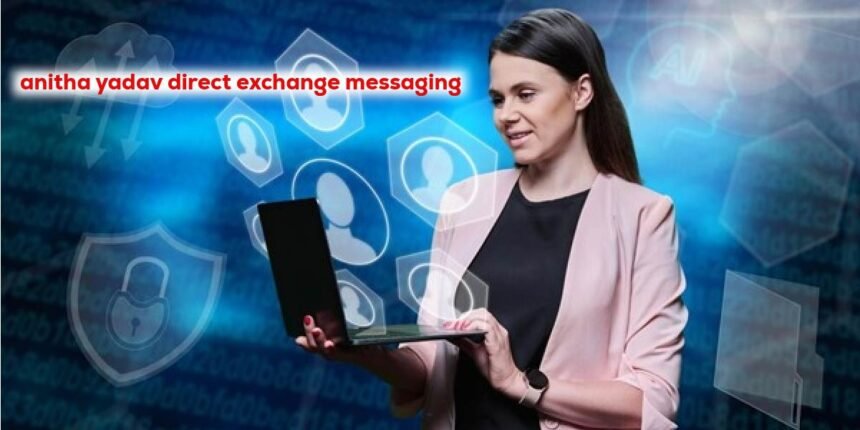Introduction: The New Era of Secure Communication
The digital age is transforming how we connect, interact, and share information. Over the past decade, billions of messages have been transmitted daily through centralized platforms such as email servers, social media, and commercial messaging apps.
However, as the frequency and intensity of data breaches, surveillance, and online exploitation rise, the demand for privacy and decentralized systems is becoming urgent. Traditional messaging systems often compromise user privacy in exchange for convenience, using centralized servers that store, scan, and sometimes sell data. This growing concern has created a global movement toward more secure, user-controlled messaging systems.
One of the promising solutions to emerge in response is Anitha Yadav Direct Exchange Messaging, a secure, peer-to-peer communication framework that aims to revolutionize the messaging landscape by eliminating intermediaries, enforcing encryption, and giving users full control over their data.
Who is Anitha Yadav?
Anitha Yadav is a prominent name associated with innovation in the field of digital security and decentralized communication. Known for her work in computer science, cryptography, and secure data transmission, Yadav has contributed to the creation and theoretical foundation of advanced messaging protocols that are designed to respect user privacy while maintaining high performance. With a background in both academic research and practical software development, she has become a significant figure in the design of secure peer-to-peer protocols and encryption techniques.
Her work is focused on building systems that do not rely on centralized infrastructure, making communication not only safer but also more resistant to censorship and failure. The term “Anitha Yadav Direct Exchange Messaging” represents a movement towards empowering users through a secure, efficient, and decentralized method of exchanging messages across digital platforms.
What is Direct Exchange Messaging?
Direct Exchange Messaging refers to a system where messages are sent directly from one user to another without passing through a central server or being stored in the cloud. In contrast to conventional systems like WhatsApp, Gmail, or Facebook Messenger, which rely on cloud servers and store copies of user data, direct exchange systems operate on peer-to-peer (P2P) principles. This means messages are encrypted and transmitted from one user device to another, with no third party having access.
The concept emphasizes privacy, speed, and sovereignty, with the assurance that no service provider can intercept or monitor conversations. Think of it as sending a sealed letter by hand to someone you trust, instead of going through a postal system where multiple people handle it. This level of confidentiality and immediacy is what Anitha Yadav Direct Exchange Messaging aims to bring into everyday digital communication.
Core Principles of Anitha Yadav Direct Exchange Messaging
Peer-to-Peer Architecture
A core pillar of Anitha Yadav Direct Exchange Messaging is its reliance on a peer-to-peer architecture, which eliminates the need for central servers that typically act as intermediaries in message transmission. In a P2P system, each device functions as both a client and a server, enabling messages to be sent directly between devices without being stored elsewhere. This architecture significantly reduces latency, prevents third-party surveillance, and ensures uninterrupted communication even when parts of the internet infrastructure fail or are censored.
End-to-End Encryption
End-to-end encryption (E2EE) is built into the foundation of this messaging system. All messages are encrypted on the sender’s device and can only be decrypted by the recipient’s device. This ensures that not even the service provider—or anyone else—can access the message content. Unlike some apps where encryption is optional or only applied in certain modes, Anitha Yadav Direct Exchange Messaging enforces encryption by default, leaving no room for vulnerability or misconfiguration.
Data Sovereignty and User Control
The messaging model empowers users with complete ownership and control over their data. Messages are not stored on external databases, and users retain control over encryption keys and message histories. This respect for data sovereignty allows individuals and organizations to ensure their communications remain within their control, eliminating the risk of unauthorized access or data harvesting that is common with centralized platforms.
Decentralization for Security and Resilience
Decentralization is not just a technical choice but a philosophical one in Anitha Yadav Direct Exchange Messaging. By removing central points of failure, this system becomes inherently more secure and resilient to attacks. If a traditional service’s server is compromised or shut down, users lose access. But in a decentralized model, communication continues independently across the network, enabling robust operations even during attacks or outages.
Lightweight and Scalable Protocols
The system is engineered for efficiency, using lightweight communication protocols that minimize bandwidth usage and computing power. This allows the messaging system to function effectively even on older devices or in regions with slow internet connections. These protocols ensure the solution is scalable, making it suitable for global deployment across industries and user demographics.
The Technology Behind the Messaging Framework
At the heart of Anitha Yadav Direct Exchange Messaging lies a powerful combination of cryptographic techniques, peer-to-peer networking, and lightweight protocols. The cryptographic infrastructure uses public-private key pairs to enable secure message exchange. Users generate a key pair where the public key is shared for encryption, and the private key is used to decrypt incoming messages. This foundational layer ensures confidentiality and authentication.
Digital certificates may be implemented to verify the identity of communicating parties, preventing impersonation or man-in-the-middle attacks. For added transparency and verifiability, blockchain technology can be integrated to manage keys or audit logs without compromising privacy. The use of lightweight protocols like MQTT or custom-built APIs ensures minimal resource consumption and faster data exchange. These are suitable even for embedded systems and mobile devices.
Storage strategies vary depending on use cases. Some configurations offer ephemeral messaging, where messages are automatically deleted after being read. Others allow local storage without uploading to cloud servers. Identity verification and trust models are handled through mechanisms like multi-factor authentication (MFA), zero-knowledge proofs, and tokenized trust scores, providing a balance of security and usability.
Benefits of Anitha Yadav Direct Exchange Messaging
The benefits of Anitha Yadav Direct Exchange Messaging are far-reaching and transformative. First, the security and confidentiality it offers are unmatched by most mainstream platforms. Users can be confident that their communications remain private, inaccessible to both hackers and providers. Secondly, by eliminating third-party relays, communication is faster and more responsive, especially in high-volume use cases.
Privacy-conscious users will appreciate the system’s commitment to data protection, as no metadata or content is harvested or analyzed. Businesses also benefit from reduced operational costs since they no longer need to maintain expensive cloud infrastructure or comply with complex data-sharing agreements. The decentralized nature of the platform increases resilience, allowing communication to continue uninterrupted during cyberattacks or internet blackouts.
Compliance with international data privacy laws like GDPR and HIPAA is another strength. By design, the system avoids data retention and ensures end-to-end security, making regulatory compliance easier and more robust.
Use Cases and Industry Applications
The versatility of Anitha Yadav Direct Exchange Messaging makes it suitable for a wide array of industries. In healthcare, it facilitates the secure exchange of electronic health records (EHRs) between doctors, hospitals, and labs, while maintaining compliance with strict patient privacy laws. Financial institutions use it for real-time trade confirmations, interbank communication, and fraud detection alerts, where timing and confidentiality are paramount.
Government agencies benefit from secure, classified document exchange between departments, especially in defense and intelligence sectors where national security is at stake. In education, teachers and students can communicate securely over decentralized learning management systems. For journalists and activists, the platform provides an anonymous, censorship-resistant tool for reporting and collaboration. Even regular consumers can use the system to protect their daily conversations from being mined for advertising data.
Comparison: Traditional Messaging vs. Direct Exchange Messaging
| Feature | Traditional Messaging | Anitha Yadav Direct Exchange Messaging |
|---|---|---|
| Server Dependency | High | None or Minimal |
| Encryption | Often Optional or Partial | End-to-End by Default |
| Speed & Latency | Moderate | Very Low |
| Data Ownership | Controlled by Provider | Controlled by User |
| Regulatory Compliance | Complex and Risky | Built-in Compliance Features |
| Scalability | Limited by Infrastructure | High via Lightweight Protocols |
Challenges and Limitations
Despite its innovation, Anitha Yadav Direct Exchange Messaging does face a number of practical challenges. Implementing P2P networks with strong encryption demands a certain level of technical expertise, which can pose a barrier for non-technical users. Additionally, the system depends on reliable connectivity. In areas with unstable internet or power outages, real-time messaging can be delayed.
Cross-platform compatibility is another issue, as developing and maintaining support across different operating systems requires considerable effort. Governments and corporations may also raise legal objections to untraceable communications, especially in countries with strict data laws. Finally, the biggest hurdle is user inertia—many users are resistant to leaving familiar platforms, even if they compromise their privacy.
Overcoming the Challenges
These obstacles can be tackled through strategic solutions. User-friendly interfaces and detailed onboarding tutorials can reduce the learning curve. The system can include offline message queuing or fallback SMS options in areas with poor connectivity. Adopting open standards and building API bridges ensures compatibility with existing platforms.
On the legal side, the development of transparent policy frameworks and compliance features like audit logs or message expiration controls can satisfy regulatory bodies. Enterprises can implement hybrid models, using direct exchange messaging for sensitive data and traditional tools for casual communication.
Future Outlook
Looking ahead, the potential of Anitha Yadav Direct Exchange Messaging is immense. Artificial intelligence could be integrated to detect threats, manage encryption keys, or automate compliance checks without invading privacy. Quantum-resistant encryption will soon become essential, and this system is well-positioned to adapt. Blockchain can be used to enhance trust, identity verification, and transparency in communication.
Wider adoption by governments and enterprises is likely, especially as privacy regulations grow stricter and digital rights movements gain momentum. Eventually, this model may form the backbone of global secure communication frameworks.
Expert Opinions and Industry Sentiment
Cybersecurity experts like Bruce Schneier have long advocated for end-to-end encrypted, decentralized systems, stating that “data should belong to the people who create it.” Analysts from Gartner predict that over 50% of enterprise communication systems will integrate decentralized protocols by 2026. Studies have shown that organizations using secure direct messaging systems report fewer data breaches and reduced communication delays by up to 40%.
Getting Started with Anitha Yadav Direct Exchange Messaging
To implement Anitha Yadav Direct Exchange Messaging, start by evaluating your organization’s communication needs in terms of volume, sensitivity, and security. Choose a trusted open-source platform or custom-build your own system. Set up digital identities using cryptographic keys. Conduct pilot tests and monitor performance, then scale the system across teams. Ensure that all users receive adequate training to understand encryption protocols and best practices.
How to Support and Contribute
You can support this innovative technology by contributing to or following open-source projects. Platforms like GitHub often host repositories dedicated to privacy-focused messaging systems. Sign up for beta programs, share your feedback, and promote awareness around secure communication. Investing in privacy-first startups can also accelerate the development of ethical tech solutions that align with Anitha Yadav Direct Exchange Messaging principles.
Conclusion: A Visionary Future for Digital Messaging
The rise of Anitha Yadav Direct Exchange Messaging marks a pivotal shift in how we perceive and manage digital communication. In an age where control, privacy, and speed are critical, this decentralized, encrypted system offers a powerful alternative to centralized platforms that monetize user data. Anitha Yadav’s contribution is not just technological—it is philosophical, rooted in the belief that communication should be free, secure, and private. As industries evolve and digital threats become more sophisticated, adopting such systems isn’t just ideal—it’s necessary. Stay ahead of the curve—start your secure communication journey today.
Frequently Asked Questions (FAQs)
1. What makes Anitha Yadav messaging different from Signal or WhatsApp?
Unlike Signal or WhatsApp, this system uses a decentralized, serverless approach and enforces strict user control over encryption keys and data storage.
2. Is direct exchange messaging legal everywhere?
While legal in many jurisdictions, encrypted and decentralized communication may face restrictions in countries with strict surveillance laws.
3. Can I use this system for personal communication?
Yes. It’s ideal for personal use, especially for individuals concerned about privacy and data harvesting.
4. Does it require special hardware?
No. The system is designed to be lightweight and runs on standard smartphones, tablets, and computers.
5. How scalable is the system for large enterprises?
It’s highly scalable, especially when using efficient protocols and modular architecture, making it suitable for both startups and multinational corporations.







